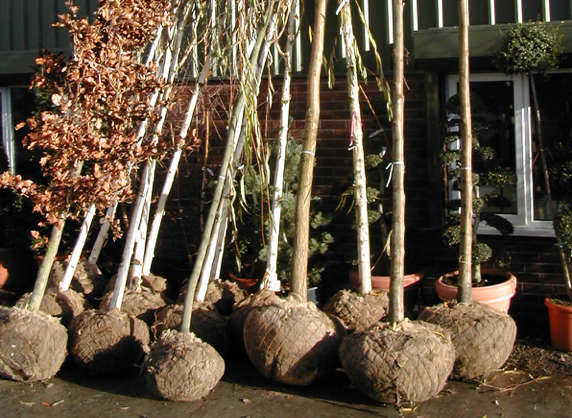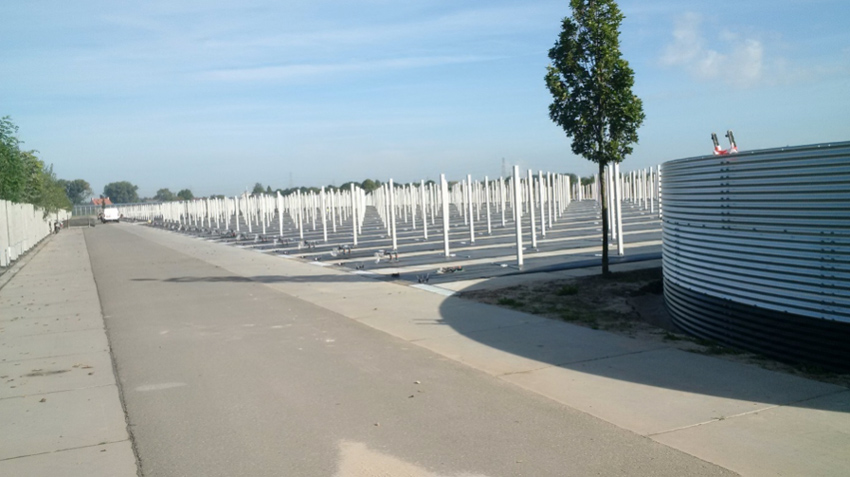What are the advantages & disadvantages of Bare rooted, Root balled & Container grown trees?
Commercial landscaping companies have traditionally planted all its trees in dormancy, during the Autumn/Winter months from mid-October to mid-March – depending on the season.
The industry requirements for yearlong planting, primarily in the construction industry where developers cannot wait until this period to market their properties, has seen a huge rise in the popularity of Container Grown and pre-rootballed or ‘coco wrapped’ trees.
So, what are the relative advantages and disadvantages of each type of production – here we take the issues affecting you as a landscaper and evaluate accordingly.
1) Cost of Initial outlay
Bare rooted (BR) trees are clearly the cheapest to purchase initially and some species will be 30-40% cheaper than a genuinely rootballed (RB) tree. Container grown (CG) are more again and are likely to be 50-60% more than RB’s. This cost is due to the additional maintenance and costs (e.g. irrigation) that CG incur for the nursery, also that the nursery has already stood the losses whilst transplanting.
Clear Winner – Bare root
2) Losses
The big advantage with CG trees is the near 100% transplanting success rate and the huge cost implications of replanting losses in the alternatives. Their fibrous root system results in the tree establishing and growing away far quicker than either other form – particularly when the container that the tree is in contains a form of air-pruning in the form of holes in the container.
In that they are often planted in summer months, irrigation is a consideration for CG trees and a large tree can take up to 20ltr of water every day. If they have been treated and grown correctly, a BR tree actually has a larger and more successful root system than RB as RB’s will have been pruned heavily at the time of dispatch to fit the size of the rootball, although RBs clearly extend the time allowed between transplanting as the roots are not open to drying winds etc.
The biggest form of losses in trees is ‘drowning’ – too much water after planting as the tree pit fills up and can actually act as a soakaway for the surrounding area. Often BR and RB trees will sit and stagnate whilst they establish themselves thus increasing this risk.
Clear Winner – Container Grown
3) Available sizes & varieties
Bare rooted trees are not normally advised over ‘extra heavy standard’; trees with a girth of over 14-16cm. Very occasionally, with the likes of Birch [Betula pendula] 16-18s are satisfactory but for many species, 12-14 is the largest considered safe for transplanting.
CG are readily available up to 30-35s and indeed in excess of that by some growers in limited numbers. As commercial growers largely produce CG trees ‘on spec’ in line with expected demand, it is not always possible to find a desired species at the desired size. Whereas years of traditional production and a vast wealth of producers throughout Europe will mean that nearly all species are available in RB.
Clear Winner – Root ball
4) Manual handling
Rootball trees will normally require mechanical handling for any tree with a girth of more than 10-12cm, thus adding significantly to planting cost. Bare root trees are generally bound in 3-5 trees in a bundle on dispatch and are easily transported by one person. Potentially the largest BR, e.g. a 14-16 would be over 25kg – even without any residue of soil on the roots and will require 2 men. This would be difficult given the nature of the object being carried.
CG up to a girth of 18-20 are normally liftable by 2 persons as handles are supplied and the medium in which they are grown is so much lighter than soil.
Clear Draw – Bare root or Container grown depending on circumstances
5) Seasonal Availability
The commercial tree growing industry has evolved massively in the past 10-15 years to respond to the need for planting trees in the summer. This is purely the concept of container grown trees as these are available for 100% of the year.
BR are only available during the dormant period which can be 5-7 months and this seasonal uncertainty is a further huge inconvenience for growers and contractors. The availability of RBs has increased in recent years by pre-rootballing and coco – wrapping. This is a perfectly acceptable and successful way of supplying trees through the late spring and early summer months and involves taking the tree out of the ground during dormancy, wrapping the RB with coco fibres and bringing into leaf above ground.
The method bears some of the features of CG trees by extending the planting season and availability, but is often confusing to traditional clients.
Clear Winner – Container Grown
So… What’s the verdict?
The verdict is simple, for smaller trees up to standards (8-10s) Bare Rooted trees will remain a perfectly acceptable and economical way of planting large numbers. For larger trees, the increased cost of container grown trees is easily outweighed by the guaranteed success rate, manual handling issues and the quicker establishment where often planting a marginally smaller tree will soon exceed the equivalent.




